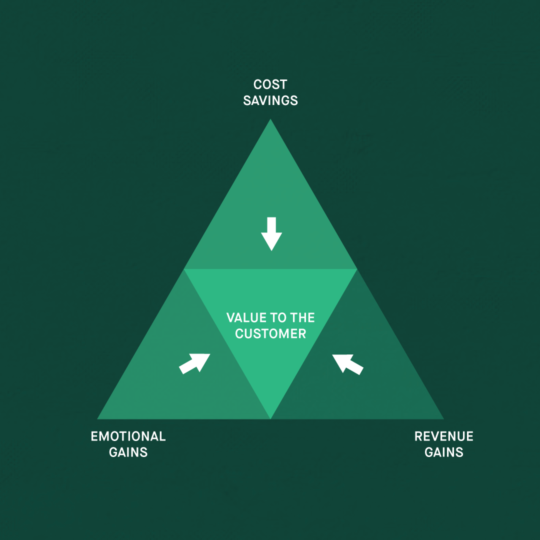
Hosted by
Sean Doyle
Sean is a principal at FitzMartin, and our leading mind and voice on sales and marketing strategy. Sean is particularly adept at applying the science of behavior change to the art of sales and marketing.
Transcript
Hello, welcome to Aligned the podcast for the executives of emerging middle-market companies, companies experiencing rapid growth, and executives who are looking for new ways to drive that growth. My name is Sean Doyle. I’m your host. Typically, we have a guest on our show, but today, I’m your guest.
I’ve been thinking about something and I want to share, with you, I believe what’s one of the most critical forms of thinking about marketing that you could possibly engage with. What I’d like to talk about today is value, this idea of value. What does it mean to the executive pursuing revenue? Well, I’d suggest that you might even see 20 to 30 percent growth in revenue just by listening to these ideas and applying them. So, let’s go. Let’s dive in.
First, what’s this idea of value so you can look at this from a value-and-fairness-being-subjective point of view, and that’s what we’re going to do. The classic in my industry is the story about Nike. What did Nike pay for a logo? Then I’m going to ask you what did Pepsi pay for a logo? And I think it’s a great demonstration of subjectivity.
So put a number in your head. What did Nike pay for a logo? Now I want you to put another number in your head. What did Pepsi pay for a logo? In fact, it’s important for you to know that perhaps you didn’t even want a new logo. They just wanted a tweak of their logo. All right. So, here’s the number.
Nike paid two hundred dollars. Pepsi paid one million dollars. So, this didn’t come down to a function of time or the investment of work put into these logos. And we’re not even going to discuss what was fair because you could argue that Nike paid a fair price. It was a college student who wanted something for her portfolio. Pepsi may have paid a fair price because they bought probably the services, one of the largest brand companies in the world. But, you know, there’s a five thousand X differentiation between those two prices. So, if Pepsi bought risk or reduction of risk and if Nike bought cheap or fast or quick-to-market, then you could certainly see how fairness is subjective and value is subjective.
But what is value? So, in marketing, we want to call value as the difference between a customer’s perspective, their evaluation of the benefits and cost of one product or service when compared with another; value might also be expressed as a straightforward relationship between the perceived benefits and perceived costs.
So, value equals benefits divided by cost. The underlying concept of value in marketing is human needs. Humans have needs that are basic — their food, shelter, belonging. But then culturally and independently, we have other needs that we would call those wants. When wants are backed by buying power, then those become a demand.
So, this is all-important and it’s important to know that, as an aside, there are different types of value: functional value, monetary value, social value, psychological value. But what we want to talk about today is a little narrower. And we’re going to zone in on the Wealth of Nations.
Adam Smith, in his book An Inquiry Into the Nature and Causes of the Wealth of Nations, in 1776, became the foundation of the economic thinking that we still use today. Much of it, at least, influences the way we think today. So, as we look for a basis of value, we can dismiss the labor theory of value. That’s the idea that you can calculate the value of something based on the inputs of labor because that didn’t take into account profits and losses. Right?
The theory didn’t account for profit. Well, Marxism. So, the difference in the form of profit is theft, value stolen. That was what Marxism launched from. So then became this subjective theory of value, where all value is in the eye of the beholder. And now I want to introduce, to this, the idea of a value triad. I think it’s a more balanced approach to looking at value.
So, the value triad states, there are three ways somebody buys value. They are looking for and purchasing revenue gain. They’re looking to purchase cost reduction. Well, most of us live in a world of understanding how to sell revenue gain or cost reduction. Most of us are comfortable in B2B with even proclaiming those numbers. Studying those numbers, having sales talk about those numbers. And then this word, emotional contribution, comes in. Well, that’s what we want to talk about today. And this is where the money is going to be made.
So, let’s talk about this customer-perceived value. If the customer-perceived value is important and they’re looking for these three aspects of it, and we want to focus not on revenue or cost, but we want to focus on emotional contribution, we should define that. The first way we want to define emotional contribution is by giving you a simple framework: past experience, marketing, social, service, quality. Those are all aspects, and not an exhaustive list, of emotional contribution.
So, what does that mean? Let’s break this down and let’s start with service. If you’re coming down to a deal, the close of a deal and you’re looking for a variation, especially if you’ve got a business that lives in the commodity space, then you’ve got to find other ways to differentiate. Or maybe there’s parity in your business, like banking or law. Well, you’ve got to find differentiators and that’s probably going to be emotional contribution. So, what would that look like if it was service? Well, you could articulate the specific service you offer, the cost of that service, perhaps it’s a value add. You could articulate that as a way to sell, as a way to help someone make a decision in the emotional contribution space. Part of that value triad is service. That’s an emotional contribution. Another way we can go is quality. We could go with social. We could go with marketing.
Let’s go. Let’s pick on quality. Perhaps one of the things you want to offer is different levels of quality. What if you didn’t have to buy the product that would last 30 years? What if you made a product that would last 10 years?
For example, I had a lawyer once, I asked if he could study a problem for me. I asked him how much it would cost to solve that problem, to figure that out. And his suggestion was $10,000. Well, I didn’t think it was a $10,000 problem. So, I said, well, what are my alternatives? He said, Well, what if I give you an 80 percent answer? I said, Well, OK, I’ll bite. What’s an 80 percent answer? And it was really simple. Is that 80 percent chance I get this right based on experience, I’m going to charge you two thousand dollars to think about it and get back with you quickly. But I want the 20 percent variance, for you to understand that I might not be right, but you chose not for me to study and think about it for the $10,000 answer. I was very pleased to buy a lower level. So, you could do that with your service industry.
Social impact is a great emotional contribution. You know, I tend to think of Caterpillar. Caterpillar is the largest in that space. But it’s really a highly fragmented space of big-things-that-move-dirt. And you could buy a lot of different, less expensive, options from all over the world. But Caterpillar has a certain cachet. And if you’re driving and operating and owning and working with Caterpillar equipment, there’s a social value to that brand marketing.
How often do you think about your products or services as being part of the way your customer could market by purchasing your stuff? Your customer actually can offer a better value proposition to their customer. Have you ever taken the time to articulate what that might look like?
Past experience with your ad agency probably told you to put them upfront and use them as testimonials to draw people in. Well, there’s actually a really, really powerful argument to be made, in the cognitive marketing model that we use, back at the stage 4/5 conversion, when someone’s an action and they’re getting ready to close the deal. But the emotional contribution of sharing past experience, lowering risk and giving even us social cachet to “Oh, you work with that person. You work in this industry. You are the leading group.” Well, that’s all emotional contribution.
So, business owners, as you think about this, I want you to consider emotional contribution as an incredibly powerful lever. Instead of offering discounts, cost reduction, instead of lowering your price, go to emotional contribution. Train your sales force to think this way. Have your marketing team equip you in these categories, in this framework so that your salespeople are ready.
Revenue gain. Perhaps you don’t want to make it as big of a deal out of revenue gain or cost reduction. Well, don’t give up on either of those. Just shift the argument, move the argument to emotional contribution.
So, the problem is in B2B markets, the supplier of strategic products and services often assume they only have two options for landing sales features benefits, cost reductions, price, but they have a lack of ability to close.
And all that happens is you lose margin, you lose revenue. Move over to this value idea. And in fact, in the next episode, I’m going to do one more individual episode around value mapping and how customers buy. And we’ll get into customers only buy for three reasons. Two of those reasons have nothing to do with finance, revenue, money.
So, let’s dive into that next. But today, I want you to walk away thinking: The value triad is important to me. There’s revenue gain. That’s a value we should be selling. There’s cost reduction. That’s a value we should be selling. There’s emotional contribution. That’s a value we should be selling.
I think you’re going to see 20, 30 percent lift when you start selling this way and add that to your toolkit. As always, we love sales. Email us at sales@fitzmartin.com and we hope this adds value to your life. Dive in!
Let’s Connect
In our podcast, Aligned, we talk about the strange and often misunderstood overlap between sales and marketing. It’s the area where most of our clients have struggled in the past — and that might be true for your company as well. If so, let’s talk about how better alignment can lead to a more profitable business.

Let’s Connect
In our podcast, Aligned, we talk about the strange and often misunderstood overlap between sales and marketing. It’s the area where most of our clients have struggled in the past — and that might be true for your company as well. If so, let’s talk about how better alignment can lead to a more profitable business.


